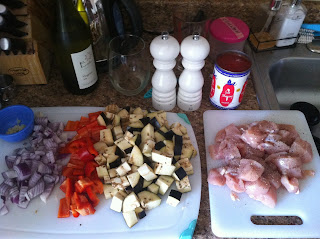Pan sauces are great
because they are essentially a one-pot meal. Also, some of the best ones
include wine, so I’m naturally inclined towards them.
Switching topics real
quick, in my family, we have a “vinegar gene”. A bunch of us really like
vinegary, lemony, brine-y foods. Mustard pickle with a side of grilled cheese?
Double trips to the pickle bar at our fave Jewish deli? Asking for a pickle if
they forgot to put one on your sandwich platter? Capers and balsalmic in your
tuna salad? Eating whole lemons ?(actually, that’s just my mother) If you, or
someone you love has shown any of these symptoms, he or she may also possess
the vinegar gene The only way to satiate it is to have multiple jars of pickles
and vinegars in the pantry at all times.
Back to pan sauces.
One of my favorite pan sauces is Piccata. I love Piccata because it includes
lots of brine-y, acidic ingredients. White wine, capers, lemon---all these
things are the tops. I guess there are zillion ways to make Piccata, and an
Italian grandmother might turn her nose up at mine, but whatever. I make it a
little different every time I make it. Sometimes it depends on my protein. If I
make a seafood Piccata, like a swordfish or salmon, I don’t flour the fish. I
just pan sear it and then make the sauce in the pan. These versions have more
lemon; with extra lemon wedges serve on the side. When I make it with chicken, and flour the
cutlets, I use more oil and butter, so the sauce has a little less edge.
Piccata is also a
favorite because it’s easy, and I generally have all the ingredients on hand. I
buy big jars of capers at Costco, and use them in pasta sauces, tuna salad, and
salad dressings.
Finished Product!
 |
| Lots of oil. |
 |
| Golden goodness. |
As I become more comfortable with pan-frying, recipes like
this turn out better and better for me. Once I got over the amount of oil or
butter it takes to get a really good golden brown, I’ve experienced excellent
results. I browned the cutlets in this recipe in olive oil, and then used a
butter and olive oil combo in the sauce. The olive oil keeps the butter from
burning, and the butter adds a rich, creaminess.
Chicken Piccata (serves 2)
For the chicken:
½ pound chicken breasts, stamped out to ½ in thick
½ cup flour
¾ cup olive oil
salt & pepper
For the sauce:
2 tbs butter
1/3 cup olive oil
1 cup white wine
Clove of garlic, minced
Pinch red pepper flakes
Juice of one lemon (see note below*)
1/3 cup capers (more or less depending on your preference)
Stamp out the chicken breasts to ½ inch in thickness. Season
the chicken with salt and pepper. Place the flour in a shallow bowl, or pie
dish, and coat the chicken evenly on all sides with flour, and shake off the
excess.
Heat the olive oil over medium-high heat. Once the oil is HOT,
ie the chicken crackles and sizzles when you touch it in the oil, place the
chicken in the pan, with space between, and brown on each side for about 3-4
minutes. Do not move it around, but monitor the heat of the pan. I turned the
burner down to closer to medium while the chicken browned and it stayed hot
enough.
Once the chicken is a nice golden brown, remove it from the
pan and place it on a plate with a paper towel to help soak up excess oil. Get
rid of the oil you friend the chicken in and wipe the pan clean with a paper
towel.
Time to get saucy.
Melt the butter and heat the oil in the pan over medium high
heat. Add the minced garlic and red pepper flakes and let it simmer for about
30 seconds. If you manage to burn the garlic, start over. You will know you
burned it because it smells gross.
Dump the wine in the pan, and allow the sauce to simmer and
the alcohol to cook off, about 2 minutes. After the initial sizzle and deglaze,
I turned the heat down to medium while it simmered. Add the lemon juice and the
capers, and allow to simmer for another 30
seconds – 1 minute. Season with salt and pepper to taste.
 |
| Couldn't you bathe in it? |
Spoon the hot sauce over the chicken and enjoy immediately.
This goes really well with pasta and roast potatoes if you want a starch, or
just by itself. If you are serving this over pasta, you might want to bump up
the amount of sauce by about a third. I
just had green beans with mine, so the sauce was just the right amount.
*If you aren’t a huge
lemon person, cut back on the lemon juice. Maybe start with juice of half a
lemon and add more at the end. One person a lemon lover the other not? Keep the
juice in the sauce minimal, and serve the chicken with lemon wedges.














